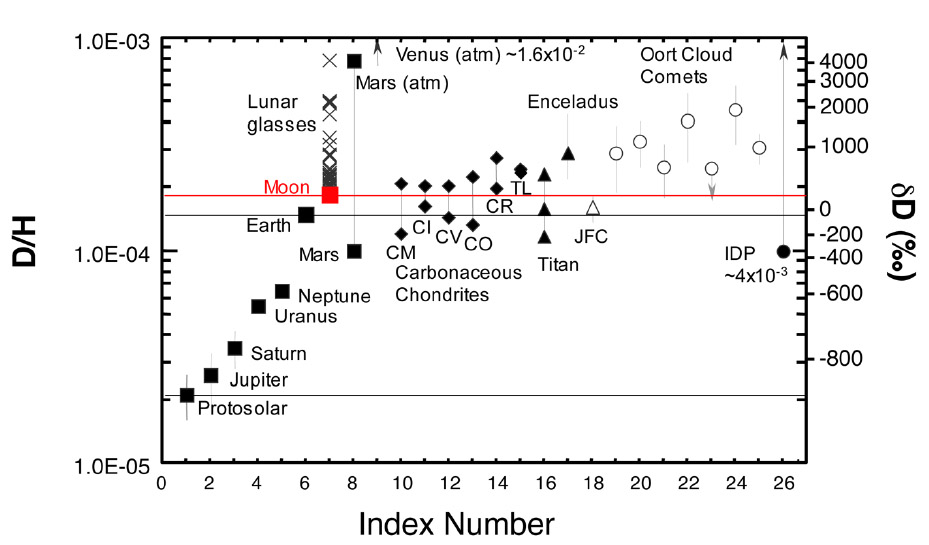Difference between revisions of "May 15, 2013"
| Line 12: | Line 12: | ||
[http://www.sciencemag.org/content/early/2013/05/08/science.1235142 Hydrogen isotopes in lunar volcanic glasses and melt inclusions reveal a carbonaceous chondrite heritage.] A. Saal, E. Hauri, J. van Orman & M. Rutherford. <em>Science Express,</em> 9 May, 2013.<br /> | [http://www.sciencemag.org/content/early/2013/05/08/science.1235142 Hydrogen isotopes in lunar volcanic glasses and melt inclusions reveal a carbonaceous chondrite heritage.] A. Saal, E. Hauri, J. van Orman & M. Rutherford. <em>Science Express,</em> 9 May, 2013.<br /> | ||
<br /> | <br /> | ||
| + | <p><b>Yesterday's LPOD:</b> [[May 14, 2013|V-Rille]] </p> | ||
| + | <p><b>Tomorrow's LPOD:</b> [[May 16, 2013|Lonesome Chain]] </p> | ||
<hr /> | <hr /> | ||
Revision as of 11:49, 7 February 2015
Heavy On the Hydrogen

hydrogen isotope diagram from Saal and coauthors, Science Express. The vertical axis on the left is the deuterium/hydrogen ratio and the right axis expresses the D/H ratio compared to the Earth. In both cases more deuterium is higher up the chart.
Isotopes are the key to family affiliations for many solar system materials. Isotopes are merely elements with more neutrons in their nucleus than is typical. An important example is oxygen, O^16, with O^17 and O^18 isotopic variants. Oxygen isotopes have long since identified the Earth and Moon as coming from the same oxygen reservoir, which is different than meteorites and Mars. Now hydrogen isotopes (H^1 and H^2 - deuterium) have been measured for tiny droplets of water trapped in lunar glasses. D/H isotopes for Earth and Moon water are nearly identical, and different from most any other place in the solar system. This means that Earth and Moon water have the same origin. That is a complication for the big swat theory of the Moon's formation, for a giant impact large enough to eject significant amounts of the projectile and Earth target rocks into space to form the Moon should have so much energy that the debris should have been totally melted, with volatiles evaporated into space. That is the case for all lunar volatiles except for water. Why? If the Moon water came from impacts when the Moon was still molten - the magma ocean stage - the water could have come from anywhere, but because the D/H ratio is the same as Earth, probably Earth and Moon got their water from the same place. It turns out that water-rich carbonaceous chondrites in the outer asteroid belt have nearly the same D/H ratio as Earth/Moon, and so do some comets. But another isotope comes to the rescue. N^15/N^14 ratios for Moon and Earth are the same as for carbonaceous chondrites but different than what has been observed for comets. So perhaps, during the accretion of Earth a rain of carbonaceous chondrites delivered water to it. And the big splat somehow preserved water, perhaps by surrounding the Earth/growing Moon within a gas-rich sheath that kept water in the system. Or continuing carbonaceous chondrites impacts delivered water to the molten Moon.
Chuck Wood
Related Link
Hydrogen isotopes in lunar volcanic glasses and melt inclusions reveal a carbonaceous chondrite heritage. A. Saal, E. Hauri, J. van Orman & M. Rutherford. Science Express, 9 May, 2013.
Yesterday's LPOD: V-Rille
Tomorrow's LPOD: Lonesome Chain



